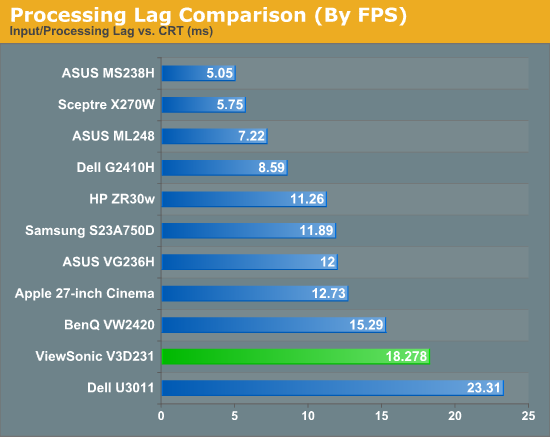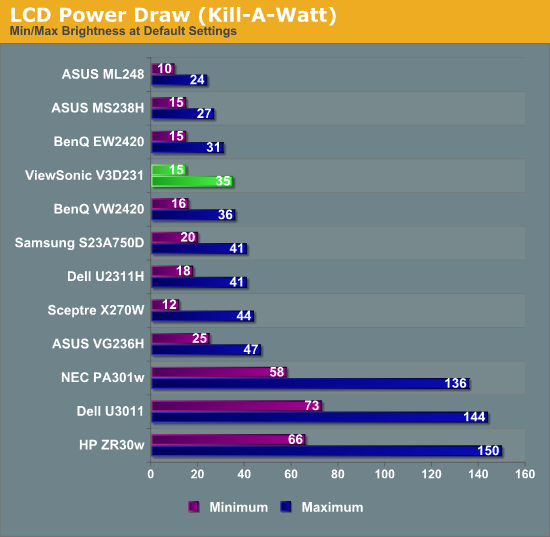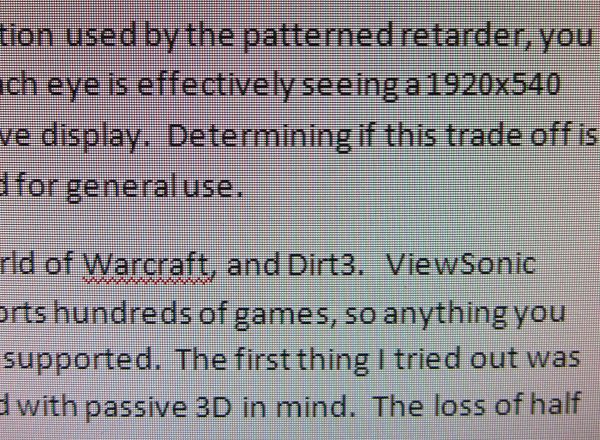ViewSonic V3D231 3D Display - The Passive Approach
by Chris Heinonen on December 30, 2011 12:00 AM ESTOf course anyone buying this ViewSonic monitor is going to be buying it for 3D use as well. As I touched upon earlier, passive 3D has some advantages over active 3D, including cheaper glasses. The main advantage in my view is that I find it far easier to watch and enjoy than active 3D. For people like myself, the opening and closing of the lenses in active 3D glasses leads to headaches and discomfort in a short period of time, and we generally avoid it. Passive 3D has none of that since your lenses are always open. This also allows more light to pass through than with an active 3D display. Additionally the technology used in passive 3D should virtually eliminate any ghosting or crosstalk in the 3D image.
Unfortunately, passive 3D does have one major downside: due to the polarization used by the patterned retarder, you only get half the effective vertical resolution from a display. Each eye is effectively seeing a 1920x540 image instead of a 1920x1080 image as you would with an active display. Determining if this tradeoff is worth it requires trying out both types of display, both for gaming and for general use. Examples of text from this review can be seen below, both with and without the glasses between the camera and screen.
For gaming tests, I relied on three main games: Half Life 2, World of Warcraft, and DiRT 3. ViewSonic provides the TriDef 3D software with the monitor that supports hundreds of games, so anything you have from the past few years has a very good chance of being supported. The first thing I tried out was World of Warcraft, and this was certainly not a game designed with passive 3D in mind. The loss of half the resolution renders the text unreadable, which is a big no-no in an MMORPG or other genre with lots of reading. During normal gameplay it was fine, but you can’t read anything that is on the screen while in 3D mode and wearing the glasses.
Half-Life 2 and DiRT 3 prove to be much better examples for the V3D231, as there is a good sense of depth in the rendering and not much in the way of artifacts. You still see some ghost objects, but I found the glasses much easier to wear and use than any active 3D glasses. The TriDef software allows for you to adjust the sense of depth and other 3D parameters in game, which lets you determine what is easiest to view. Objects that appear to come out of the screen, instead of going back into the screen, can often cause more eye strain and fatigue, so if you find yourself getting tired you can reduce the level of depth in the image to compensate. While I think that 3D can add something to the experience, passive 3D does add a lot of aliasing due to the loss of vertical resolution, and I feel that a 120Hz refresh rate made for a more natural, immersive experience than passive 3D does.
For watching movies, passive 3D is a tossup once again. The recent 3D Blu-ray release of The Lion King looked just fantastic. Crosstalk and ghosting were practically non-existent I found, and the loss of resolution really didn’t bother me much with the animation. However, as soon as I put on the 3D Blu-ray of Tron Legacy, I found myself wishing for an active 3D display. The combination of black backgrounds and bright, angled lines led to aliasing all over the image and was really quite distracting. Tron is my worst case disc for passive 3D, as it seems to show off the downsides more than anything else, and that is the case here.
Running crosstalk benchmarks, the ViewSonic seems to do much worse than the prior active 3D Samsung, but the results on the ViewSonic are incredibly dependent on my head angle and location. If I shift just an inch to the side I get totally different numbers, so I tried to maintain my head in the dead center. Since it is a passive display, the numbers seem much higher than they should be, but I made certain that every measurement was as accurate as I could make it.

For non-3D gaming, I put the ViewSonic through the usual lag tests, with both faster and regular response enabled. I found no differences between the modes in testing, so there is only one set of numbers presented here. The ViewSonic averages just about 1 frame of lag in comparison to the ViewSonic CRT next to it. I had no issues using it for general gaming, but people that need better response will want to look at some other options.

Hooked up to the Kill-A-Watt, the ViewSonic maxes out at 35 watts with a full backlight, and 15 watts with the backlight at minimum. This is higher than other TN displays with LED backlights and closer to IPS or VA panels. Given the higher power usage I wish the light output had been higher than it is.













42 Comments
View All Comments
velis - Friday, December 30, 2011 - link
...That said, it is said that LG will introduce new high resolution passive 3D monitors at this CES. Assuming that vertical resolution really reaches at least 1600, I'd really like to see those monitors reviewed as soon as possible.
cheinonen - Friday, December 30, 2011 - link
If LG has a new, high resolution, passive 3D monitor at CES I'll certainly talk to them about it, right after I look at their OLED and 4K display demonstrations. Even a 2560x1440 LCD would be able to do full 720p resolution for passive 3D and would look far better.I'm not a big 3D person, but typically prefer passive when given the choice. I'm testing out an active 3D projector on my 122" screen right now and it's much easier on the eyes than watching an active 3D monitor I find, but the glasses still are not as comfortable and are more expensive. I'll talk to who I can at CES about anything that I see.
jkostans - Friday, December 30, 2011 - link
It's going to be 2012 very soon and we still haven't come up with a good CRT replacement.60Hz is choppy,120Hz should be the industry standard by now
Viewing angles still suck (120Hz panels)
Color quality is still a problem, especially from the factory
Uniformity is still not great
Resolution is fixed and there are only 1080p and lower options (120Hz)
ANY Input lag is inexcusable
LCD should be a very mature technology by now but it seems people would rather pay for cheap crap than invest in a nice display. No wonder the manufacturers haven't fixed any of these problems, it's not worth the R&D time. Why people are even bothering with 3D is beyond me. I got my fix in 2000 with the ELSA revelators. Pretty cool effect for a little while but nothing game changing. A 3 monitor setup provides much more immersion than a single 3D display in my opinion.
snarfbot - Saturday, December 31, 2011 - link
its always going to have some level of lag with a fixed pixel display, it has to update the screen all at once so it has its own framebuffer that stores the image as it gets it from the source.its possible that the source say a videocard could have a general controller that supported every different type of display but then they would need a standards group and all that. also it would remove the ability of display manufacturers to provide different levels of features for their products, in effect, they would just be branding the panel and thats it. it really doesnt make business sense for them to cooperate in something like that.
anyway, it would just move the logic from the display to the source, and might not necessarily improve anything. besides, theres already enough complexity in the display chain, without introducing yet more cost and compatibility issues.
it would be nice to start over from scratch, get a standard that is forward thinking, drop all legacy baggage etc, (why do fixed pixel displays overscan? which basically involves cropping and upscaling? one of lifes great mysteries.) but i dont see it happening in my lifetime unfortunately.
Anthony RAmos - Friday, December 30, 2011 - link
Actually Chris, display specialist, Dr. Raymond Soneira, proved that Passive actually provides full HD 3D in the study below:He also showed that Passive is very often better than Active 3D at resolution tests because of complex timing issues between Active glasses and the set. Read below:
"The theory and fundamental principle behind full FPR vertical resolution and sharpness is that the 3D TV images have only horizontal parallax from the horizontally offset cameras, so the vertical image content for the right and left eyes are in fact identical – but with purely horizontal parallax offsets from their different right and left camera viewpoints. So there isn’t any 3D imaging information that is missing because all of the necessary vertical resolution and parallax information is available when the brain combines the right and left images into the 3D image we actually see. So as long as the viewing distance is sufficient so that the raster lines are not visually resolved (for 20/20 vision the visual resolution is 1 arc min, which corresponds to 6.1 feet for a 47 inch TV) the brain should fuse the images from the right and left eyes into a single full 1080p resolution 3D image. One important detail to note is that there are actually two entirely equivalent odd-even and even-odd line pairings for both the right and left FPR images, so both FPR TVs alternate between them at their full Refresh Rate. This also eliminates image artifacts that would result from picking just one pairing or the other.
That is the theory and principle behind 3D Image Fusion for FPR, so now we need to actually test it to see how accurate it is and how sharp the 3D images actually appear. This can not be evaluated with instrumentation or cameras – only visually – but it can be done in an analytic and systematic fashion with objective quantifiable results that anyone can duplicate at home to verify our results and conclusions on 3D TV imaging and sharpness for themselves. Here’s how…"
http://www.displaymate.com/3D_TV_ShootOut_1.htm#Im...
JarredWalton - Friday, December 30, 2011 - link
It sounds like that doctor went in with a desire to prove that passive was better than active. Moreover, it sounds as though he only worked with film/TV sources. Whatever the case, Chris tested this particular LCD and played games on it, and the result is that text in his opinion was more difficult to read.Perhaps if he was at least 1 arc minute away from the display it would have worked better. Consider this statement: "But it’s not that simple because we watch TV from a far enough distance that the lines are not resolved and we know that the brain combines the images from both eyes into a single 3D image (the one we actually see) in a process called Image Fusion." His evaluation of active vs. passive points out many of the advantages of passive (less/no flicker and crosstalk), but while all of that may be true, the vertical resolution controversy is hardly disproved by his opinion.
Again, a quote: "Because they split the odd and even lines between the right and left eyes it’s easy to see why many people (and some reviewers) conclude that FPR technology delivers only half of the HD resolution. Although unsubstantiated it still seems to have evolved into some sort of myth based on hearsay instead of actual scientific visual evaluation." Scientific visual evaluation seems to me to correspond to "personal subjective evaluation", with science not necessarily involved. More importantly, what happens if you're not far enough away? Then suddenly you see the reduced vertical resolution show up. I still use a 1080i HDTV for my home, and while it works fine for video content, it's horrible for text unless the text is very large (e.g. 10 foot UI).
Ultimately, I also prefer passive 3D for viewing 3D content, but I'd prefer to have 120Hz LCDs more than passive 3D. 120Hz helps in non-3D use (quite a bit actually, in my opinion), and I still feel 3D is largely a gimmick that I don't need or even want. But then, you know what they say about opinions. :-)
robinthakur - Wednesday, January 4, 2012 - link
It's an interesting (and evolving) subject. On LG's bigscreen Cinema 3D TV's with the latest firmware you can now select what format the passive 3D is displayed in. One displays native passive 1080i to both eyes meaning that you actually don't lose any resolution because the eyes de-interlace them. The other mode displays with half vertical resolution 540p to both eyes. However, in terms of which looks better when you are watching it, I have to say that I see very little difference with either, so alot of this is entirely perceptual. I concede that on a small screen monitor, the negative effects will likely appear far larger than it would be a on a larger screen, but the technology itself is not inherently worse than active, just from the specs on paper.cheinonen - Friday, December 30, 2011 - link
The ViewSonic has now left my possession, but as both it and the previously reviewed Samsung are targeted at gamers for 3D, the ViewSonic just did not work for games with heavy text levels. The screenshot I attached did a decent job of replicating the effect, but often text was totally illegible and I had to get away from 3D to read it. This was not an issue with the Samsung, but the active 3D caused me other issues.I've reviewed a fair number of active and passive TVs as well, and while I have preferred the passive 3D for watching, the lack of resolution made titles like Tron Legacy harder to watch with the aliasing, but also easier on the eyes due to the passive nature. The most enjoyable 3D experience I've had so far at home is with the JVC X30 projector on a 122" projection screen, as I found I had no headaches or anything else from it. The JVC can run at 96 Hz natively, but I am not sure if that is what they are doing with 24p film content or not, but plan to find out. Even a 50" plasma with active 3D started to give me a headache after some time.
I think the eventual future of 3D is 120 Hz or 240 Hz passive displays with enough resolution (or the Real3D projector that Samsung was working on but abandoned this year) to provide the 1080p experience with passive glasses. The cost benefits, and and more relaxed viewing, make it my preferred choice, but the loss of resolution is a killer for me right now. I also think they need to find a way to deal with the texture from the patterned retarder, as when I notice it, I am driven absolutely crazy by it.
OCNewbie - Friday, December 30, 2011 - link
I had recently heard about this monitor through the AT forums, and had been looking for a review without any success. I had been considering getting it anyway, but now my purchasing (or not purchasing) decision will be made with much higher confidence thanks to this review.mggstechco - Friday, December 30, 2011 - link
So far, LG has the fastest growth in 3D Experience and customer-acceptance in the world. Though they may not be the biggest market share now.-----------------------------
Most Favorite 3D Experience LED TV http://lg42lw5300.net